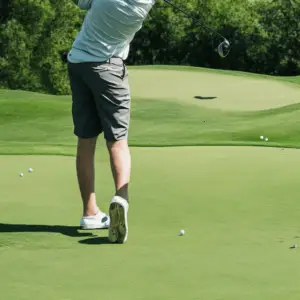Last Updated on October 16, 2023
The golf swing is a complex motion that requires precise coordination and timing to execute properly. Turning your hips in the golf swing is one of the most important aspects for achieving maximum power, accuracy, and distance on every shot. Turning your hips in the golf swing may seem simple, yet mastering this skill takes practice and dedication – read on to learn why it’s so important and how to do it right. In this blog post, we will provide tips on how to turn hips in golf swing while avoiding common mistakes along the way. So let’s get started exploring all things related to hip turn in golf swings.
Table of Contents:
- The Benefits of Turning Your Hips in Golf Swings
- How to Turn Your Hips in Golf Swings
- Tips for Improving Your Hip Turn in a Golf Swing
- Conclusion
The Benefits of Turning Your Hips in Golf Swings
Rotating the hips in a golf swing is an essential element of executing a successful shot. The hip turn helps to create power and accuracy, and it can be the difference between a good drive and an exceptional one.
The first benefit of turning your hips in golf swing is increased power. When you turn your hips correctly, you generate more torque on the clubhead, resulting in greater distance off the tee. This extra distance gives you more room to work with when approaching greens or other hazards. Additionally, if you have trouble getting out of bunkers or roughs due to lack of power, focusing on proper hip turns can help give you that extra boost needed for success.
Another key benefit of turning your hips during a golf swing is improved accuracy. As mentioned above, generating more torque allows for greater control over ball flight and direction; this makes it easier to hit fairways and avoid obstacles such as water hazards or trees. Turning your hips also helps prevent slices since they rotate around the spine at impact rather than away from it, like an open-faced club would do with no hip turn involved in the motion.
Lastly, having good hip rotation will improve consistency throughout each round by allowing players to repeat their swings time after time without any major changes required between shots—especially useful when playing longer courses where fatigue could become an issue later on down the line.
How to Turn Your Hips in Golf Swings
Many amateurs struggle with this technique and make common mistakes that can lead to an inconsistent game. However, with the right tips and techniques, you can master hip turn in no time.
The first step to getting a good hip turn is understanding how it works. The key concept here is “weight shift” – when you take your backswing, you should be shifting your weight from one side of the body to the other as you rotate around a central axis. This will help create power for your shot while keeping balance throughout the motion.

Once you understand what’s happening during a hip turn, it’s important to practice proper form. Make sure that when swinging back and through, both feet remain planted firmly on the ground – don’t let either foot slide or move forward or backwards during the swing. Also, ensure that all of your body parts are working together: arms should be in sync with legs, shoulders rotating at the same speed as hips, etcetera. This helps generate more power while avoiding injury caused by over-rotation or improper movement patterns.
Once you’ve achieved the highest point of your swing, make sure to rotate fully until your waist has gone as far as it can without compromising either equilibrium or stance. Then, at that point, initiate the downward movement swiftly in order to get optimal control and power over the ball’s trajectory, and distance travelled when hitting off from below the tee box.
Finally, remember that practice makes perfect – so keep practising until those muscles become second nature. With enough repetition and focus on form and technique, any golfer can improve their hip turn significantly, leading them closer towards achieving better scores out on the course.
By utilizing the instructions provided in this article, one can master how to rotate their hips properly while swinging a golf club. In order to steer clear of typical blunders, one should be aware of the causes and utilize tactics to avoid them.
Tips for Improving Your Hip Turn in a Golf Swing
One of the most important aspects of a golf swing is having an effective hip turn. An effective hip turn can lead to better shots that are longer and more precise. Here are some tips to help improve your hip turn:
1. Focus on Your Core Strength
To properly rotate your hips during a golf swing, you need strong core muscles that will support the movement. Make sure to incorporate exercises into your routine that focuses on strengthening these muscles, such as planks or sit-ups. This will give you more stability and power when turning your hips in the golf swing.
2. Practice with Visualization
Before taking a practice shot, try visualizing how you want to move your body during the motion of the golf swing – from start to finish – including focusing on proper hip rotation technique. Doing this regularly can help ingrain good habits and muscle memory so that when it comes time for actual play, everything flows naturally without conscious thought or effort required from you.
Ensure that your shoulders remain parallel and arms relaxed for the duration of your backswing to guarantee maximum flexibility when swinging, thus allowing better control over each ball’s trajectory after being struck from either the tee box or fairway. Achieving a proper posture is key in executing an effective hip turn – if not kept upright, all other body parts will become misaligned, leading to underwhelming performance capabilities. Unlocking higher levels of play starts with reinforcing good habits, so hone in on strengthening those core muscles by incorporating exercises like planks and sit-ups into your routine. Visualize how you want to move throughout every part of the golf swing as well; this way, muscle memory kicks in during actual gameplay without needing conscious effort.
Once you have mastered proper posture while practising the visualization techniques mentioned above, take advantage of momentum by starting slow but increasing speed gradually until reaching peak velocity just before impact occurs. This helps maximize the distance travelled. You should also make sure your head stays still throughout the entire motion since any sudden movements here could throw off the whole rhythm set up earlier due to its proximity relative location compared to the rest of the torso area involved. Too much swaying would cause inconsistency between clubface angle upon contact versus desired trajectory goal intended to be achieved, ultimately resulting in poor shot execution quality wise regardless of hard work put forth beforehand trying to get things right initially.
Conclusion
Turning your hips correctly in a golf swing can be the difference between an average shot and a great one. With practice, you will learn how to turn your hips properly with proper technique while avoiding common mistakes that lead to bad shots. When done right, turning your hips during the golf swing gives you more power and accuracy off of each tee or fairway shot. Keep practising, and soon enough, you’ll have mastered this important skill.



